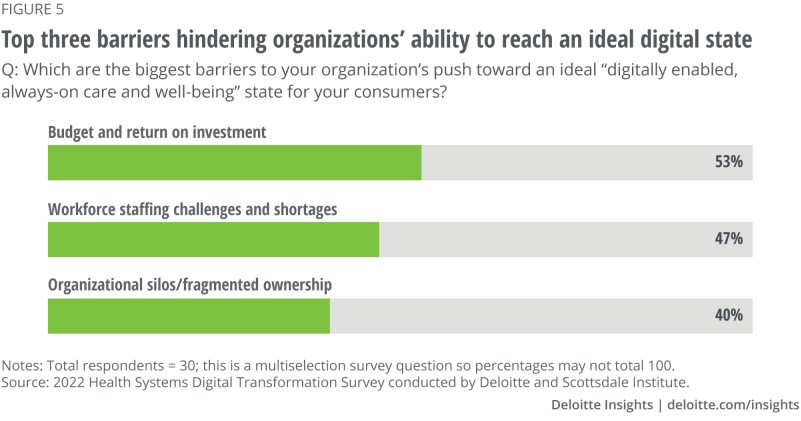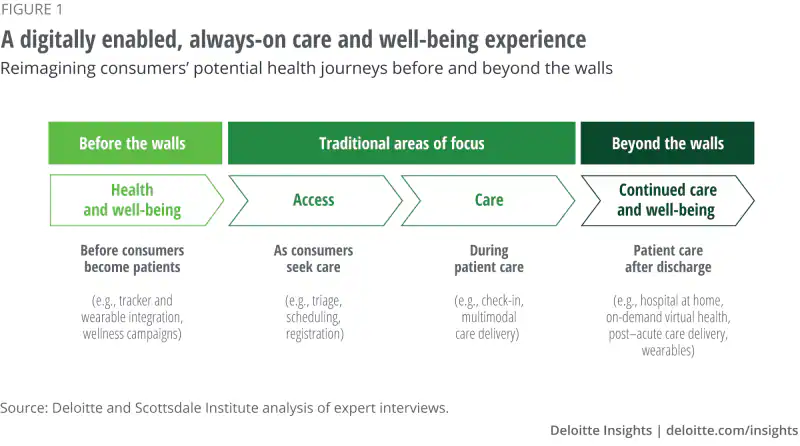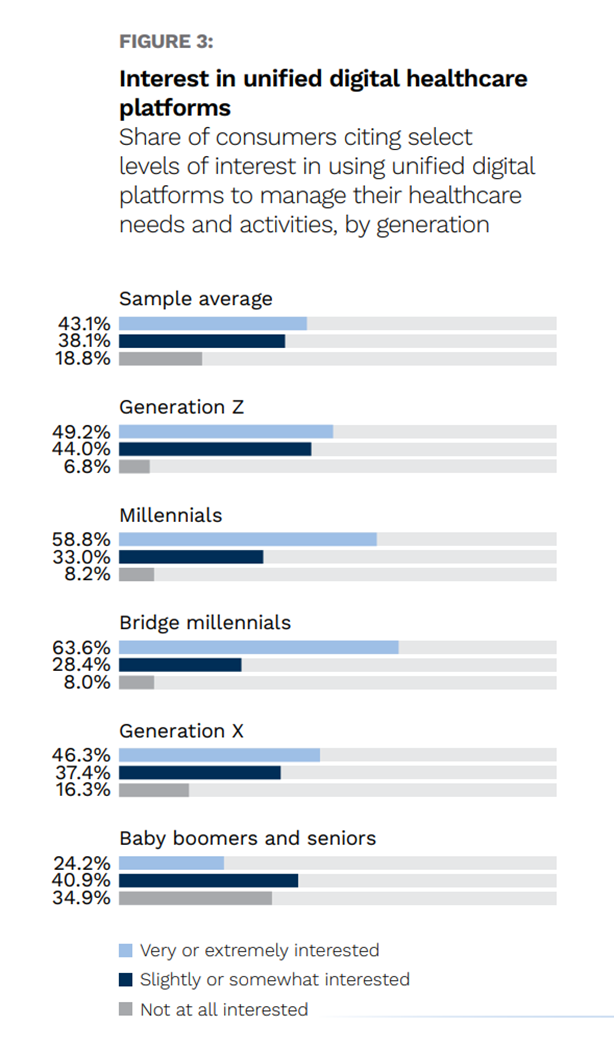Hospitals’ and health systems’ core competencies have been serving patients “within the walls” of their organizations and institutions.
As health systems continue to evolve value-based services while meeting patients’ consumer-oriented demands for convenience and personalization, digital transformation is required, enabling care “beyond-the-walls.” We learn more about this vision and how to map the journey to getting there in the report Integrating digital health tools to help improve the whole consumer experience from the Deloitte Center for Health Solutions and the Scottsdale Institute.

This report is based on detailed interviews with experts in 30 US health system conducted between November 2022 and March 2023.
The 3 key learnings were that,
- Health systems’ digital transformation projects are increasingly focused on consumers’ health and well-being versus strictly medical needs, although…
- The “ideal digital state” remains elusive, as health systems’ understand how to deal with operations “within-the-walls” but, as care shifts to health and well-being, services must be delivered beyond-the-walls; and,
- Health systems have identified the top three barriers in the way of reaching that ideal digital state: financing the digital projects, staffing challenges and shortages, and fragmented ownership of the digital programs.

Deloitte and the Scottsdale Institute layout the always-on care and well-being experience, moving from within the walls to before the walls and finally beyond the walls, shown in the second graphic from the report.
As the journey map illustrates, the consumer flow begins before that consumer becomes a patient, armed with wearable tech and online information that then can lead to the person needing to access care — the on-ramp to hospitals’ traditional focus areas from triage to scheduling and registering the patient into the system’s care and “walls.”
Once cared-for, the patient can be discharged back into their community, “beyond-the-walls” to home or other neighborhood care site for post-acute care, rehabilitation, or therapy for continued care and restored well-being.
Health Populi’s Hot Points: “Ownership of digital initiatives is a[nother] challenge leaders are grappling with. Strategy, clinical, digital, tech — all departments have collective interest, but there’s also fragmented ownership and decision -making,” one of the study respondents explained. The report asserts that health systems must break down siloes and re-define/-imagine ownership of the digitally-enabled consumer health journey.

Health consumers, across generations, are interested in unified digital healthcare platforms, new research from PYMNTS and Lynx found in their May 2023 report, The Digital Platform Promise.
The subtitle for the report is “what Baby Boomers and Seniors want from digital healthcare platforms.” As illustrated in the bar chart from the research, 65% (2 in 3) U.S. Boomers and Seniors are interested in accessing a unified digital platform to manage their healthcare needs and activities.
In this study, those activities included access to pharmacy benefits (including drug discount cards); accessing information on medical, dental and vision insurance; scheduling appointments; checking-in to upcoming appointments; and, connecting with healthcare providers’ websites or patient portals.
Boomers and Seniors indexed higher for each of these areas than younger patients in the Gen Z, Millennial, Bridge Millennial, and Gen X cohorts.
This is an exciting finding for healthcare providers in that older U.S. patients have grown comfortable using digital front-doors to health care.
As patients-as-consumers seek more care at home and at-/in-hand, this applies to older people as well as younger health consumers who were earlier adopters of wearable tech for health and fitness and digitally-native in general.
I’ll dive further into the PYMNTS/Lynx study later this week here in Health Populi. For the Deloitte digital health bottom line, we’ll look to health systems to meet patient-consumers where they live, work, play, learn, and shop, evolving care model designs, bolstering workforce readiness, and investing in technology infrastructure and interoperability to enable care to move, fluidly, from “within-the-walls” to “beyond-the-walls.”




 Interviewed live on BNN Bloomberg (Canada) on the market for GLP-1 drugs for weight loss and their impact on both the health care system and consumer goods and services -- notably, food, nutrition, retail health, gyms, and other sectors.
Interviewed live on BNN Bloomberg (Canada) on the market for GLP-1 drugs for weight loss and their impact on both the health care system and consumer goods and services -- notably, food, nutrition, retail health, gyms, and other sectors. Thank you, Feedspot, for
Thank you, Feedspot, for  As you may know, I have been splitting work- and living-time between the U.S. and the E.U., most recently living in and working from Brussels. In the month of September 2024, I'll be splitting time between London and other parts of the U.K., and Italy where I'll be working with clients on consumer health, self-care and home care focused on food-as-medicine, digital health, business and scenario planning for the future...
As you may know, I have been splitting work- and living-time between the U.S. and the E.U., most recently living in and working from Brussels. In the month of September 2024, I'll be splitting time between London and other parts of the U.K., and Italy where I'll be working with clients on consumer health, self-care and home care focused on food-as-medicine, digital health, business and scenario planning for the future...